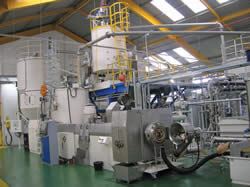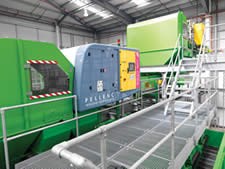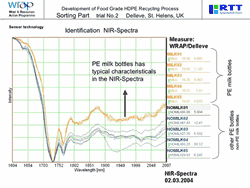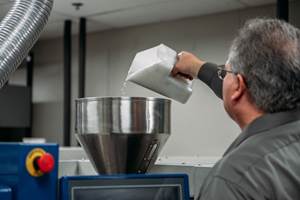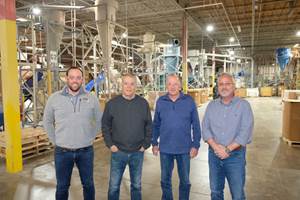New Processes for Food-Grade Recycled HDPE
Recycling HDPE homopolymer from milk and water bottles back into food-grade bottles is a new achievement that was featured at the Plastics Recycling Conference, sponsored by Resource Recycling magazine, and at the SPE Global Plastics Environmental Conference (GPEC 2009), held back to back in Orlando, Fla., last month.Removing volatiles from HDPE to meet U.S.
Recycling HDPE homopolymer from milk and water bottles back into food-grade bottles is a new achievement that was featured at the Plastics Recycling Conference, sponsored by Resource Recycling magazine, and at the SPE Global Plastics Environmental Conference (GPEC 2009), held back to back in Orlando, Fla., last month.
Removing volatiles from HDPE to meet U.S. FDA and EU standards for reuse in food bottles is harder than removing volatiles from PET. HDPE absorbs more volatiles and is processed at lower temperatures than PET.
Two technologies so far have met the FDA protocol. One is proprietary, the other commercially available. Envision Plastics in Reidsville, N.C., owns the proprietary process, developed originally by Union Carbide Corp. in the 1990s, and acquired in 1998 by Ecoplast Corp., Los Angeles, a sister company to Envision. Union Carbide (later acquired by Dow Chemical) received a letter of no objection from the FDA in January 1998 for use of the recycled material in milk, water, and juice bottles.
The process relies on a fluidized bed aerated by hot gas. The patent (U.S. # 5767230) describes removing volatiles by blowing hot air through HDPE flake at 1 to 4 ft/sec at temperatures of up to 120 C for 1 to 10 hr. UCC’s prototype decontamination vessel was shipped to Envision and has been modified several times since.
The vessel is used to produce sample quantities of Envision’s EcoPrime FDA-grade post-consumer HDPE. The process can remove volatiles to a level substantially below the FDA’s protocol for letter of no objection (<320 ppb of volatiles), says Ecoplast CEO Parham Yedidsion. Envision has designed a production-scale unit but has not announced when or where it will be built. Envision won a $1,345,000 grant from the state of California to install an optical sorting system for HDPE bottle flake in its Chino, Calif., plant. Such a system would be required for food-grade production.
U.K. MILK BOTTLE ‘LOOP’
The first commercially available process to recycle food-grade HDPE bottles was developed in the U.K. over the last four years with funding from WRAP (Waste & Resources Action Programme), a government initiative to reduce waste. The process was developed by a consortium of Nampak Plastics, a South African blow molder of milk bottles, and several large dairies and supermarket chains. The Fraunhofer Institute in Germany tested and qualified the process.
The critical decontamination unit in the WRAP process is a modified Vacurema system from Erema Engineering Recycling Maschinen und Anlagen GmbH in Austria. It’s like the Vacurema machine used in PET recycling to maintain high I.V., but is modified for devolatilizing HDPE at a lower temperature but longer time in the vacuum chamber. HDPE flake is heated to 120 C under vacuum in a succession of two chambers to get longer dwell time. PET flake passes through one Vacurema decontamination chamber at 230 C, notes recycling consultant Ed Kosior of Nextek Pty. Ltd., another British partner in the WRAP development. Compared with the PET version, the HDPE extruder also has a screw with a longer L/D, vacuum vent, and die-face pelletizer, whereas the PET version is unvented and uses a strand pelletizer.
Two U.K. plants started up last year using the Vacurema process—Closed Loop Recycling Ltd. in Dagenham, near London; and Greenstar WES Ltd. in Redcar, Teeside. Both are beginning to supply food-grade PCR HDPE to Nampak for testing in milk bottles.
Closed Loop Recycling has a 13-million-lb/yr Vacurema system for HDPE, partly funded by WRAP, which started up last summer. The firm has been pelletizing PCR HDPE for three months, but the initial output was “technical quality,” not food grade, while it tuned the process to meet volatiles specifications. It will begin shipping commercial food-grade material to Nampak by this month, taking a sample from each 800- to 1500-kg shipping sack and testing it off-line in a gas chromatograph before the material is shipped. Closed Loop is now building a second plant twice the size of the original—for 26 million lb/yr—in North Wales, expected to start late this year.
Greenstar started up last spring with the first Vacurema unit built for PCR HDPE, rated at 13 million lb/yr. Greenstar passes finished pellets past an “electronic nose” from Alpha MOS in France to “sniff” for any remaining volatiles. If volatiles are found, the material becomes “technical polymer,” not food grade. Greenstar began shipping food-grade HDPE last summer for sheet to thermoform chicken trays. It also shipped material to Nampak for testing in milk bottles early this year and hopes to begin commercial shipments in a few months.
AWS Eco Plastics Ltd. in Newcastle-Upon-Tyne, U.K., is commissioning a mixed-bottle recycling plant for food-grade PET and is expected to add recycling for food-grade HDPE next year. Nampak expects to buy enough recycled HDPE from these plants to meet its goal of putting 10% PCR in its milk bottles this year, 20% next year, and 30% to 50% thereafter.
SORTING NONFOOD BOTTLES
Bales of natural HDPE bottles include a small but growing fraction of copolymer bottles for detergent and dishwashing liquids, which are loaded with perfumes and oils. These aren’t allowed in food-grade HDPE. Both the Envision/UCC and WRAP/Erema decontamination technologies have FDA letters of no objection that specifically say the feedstock has to be food/beverage bottles.
Milk and water bottles are HDPE homopolymer; detergent bottles are copolymer. Natural copolymer bottles constitute less than 2.1% of all HDPE bottles in Europe, according to the Fraunhofer Institute, which counted flakes in hundreds of test samples. The ratio in the U.S. isn’t known, but copolymer HDPE is growing in both regions as the packaging of choice for new environmentally friendly detergents. Natural homo- and copolymer bottles can’t be mechanically separated by density, and are now separated by hand.
RTT Systemtechnik GmbH in Germany, also a partner in the WRAP program, identified the different near-infrared (NIR) spectra for copolymer and homopolymer HDPE for use in its Unisort NIR automated mechanical separation system. WRAP says this system was tested successfully two years ago on bale quantities. It isn’t being used so far by any of the food-grade recyclers.
But it will be used soon by one of their suppliers. The first commercial Unisort system to remove natural copolymer HDPE detergent bottles from homopolymer milk and water bottles will be installed in a few months at Cherry Polymers’ plastic bottle sorting plant in Crumlin, Northern Ireland, which supplies bottles to food-grade recycling plants.
Meanwhile, Greenstar’s separation process starts with baled HDPE bottles and removes 90% of colored HD bottles and caps with Visionsort automatic color sensing from Titech AS in Norway (represented here by Lubo USA). Then operators hand sort nonfood from food-grade bottles before they are shredded and granulated. Flake then goes through a continuous, dry cleaning process from Pla.to GmbH in Germany to remove paper labels, followed by a hot washing system from Sorema Srl in Italy (represented in the U.S. by Common Sense Solutions), and then by density separation in a large Sorticanter centrifuge from Flottweg AG in Germany. The product is next optically sorted with a “rice sorter” from S+S Separation & Sorting Technology GmbH in Germany to remove any remaining colored flakes.
Closed Loop takes in mixed bottles, so it starts by automatically separating PE from PET bottles with NIR sortation from Pellenc ST in France (represented here by Machinex) and then removes colored HDPE bottles with Pellenc’s vision sorting. Natural detergent bottles are removed by operators at four sorting stations.
Related Content
Extrusion Technology Extended to Injection, Enabling Up to 100% Regrind Usage
Twin-barrel (shot-pot) press can handle more regrind, offers other benefits to molders.
Read MoreMarket Changes Spur Industrial Recycler to Enhance Capabilities in Clear Plastic Reprocessing
Butler MacDonald found new business and flexibility thanks to a big step-up in purging efficiency.
Read MoreEvolving Opportunities for Ambitious Plastics Recycler
St. Joseph Plastics grew from a simple grinding operation and now pursues growing markets in recycled PP, food-grade recycled materials, and customized post-industrial and post-consumer compounds.
Read MoreStar Plastics Achieves ISCC Plus Certification
West Virginia-based custom compounder adds to its sustainability credentials.
Read MoreRead Next
For PLASTICS' CEO Seaholm, NPE to Shine Light on Sustainability Successes
With advocacy, communication and sustainability as three main pillars, Seaholm leads a trade association to NPE that ‘is more active today than we have ever been.’
Read MoreLead the Conversation, Change the Conversation
Coverage of single-use plastics can be both misleading and demoralizing. Here are 10 tips for changing the perception of the plastics industry at your company and in your community.
Read MoreSee Recyclers Close the Loop on Trade Show Production Scrap at NPE2024
A collaboration between show organizer PLASTICS, recycler CPR and size reduction experts WEIMA and Conair recovered and recycled all production scrap at NPE2024.
Read More



